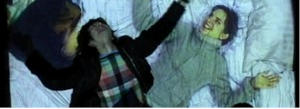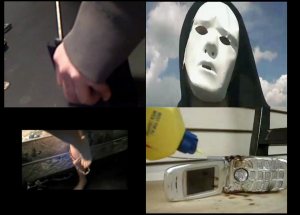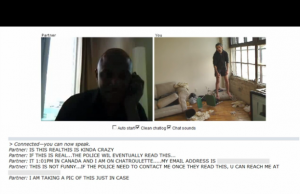Participating in “we r now[here]” was an amazing experience. I had more of a stage managing role rather then a performer. It was my responsibility to make sure everyone was on time, remembered the routine and where to be. This experience allowed me to have an inside view into the performance. I was able to watch part of the performance on the screen, as well I was able to watch it live as it was happening.
This performance reminds me of Jenicam. Jenni used the webcam as a passage for people to have an inside view into her life. she was able to show others how she lived and it was deemed as very entertaining to view the life of another person. Through the performance, we were showing others our environment and what we saw and were experiencing through the cam. Annie Abrahams, discusses a similar social experiment using the webcam that took place in 2009. Two people choreographed a dance routine solely using webcam. They used their webcams as the form of communication an expression, similar to Jennifer and similar to our performance. Abrahams states that the performers are “alone together”. This is how I feel about the performance. All of the people were in their own space, starting at different points of the room. They were showing their own space through the lens of their webcam to the audience. This changes when everyone comes together in the theatre and puts the focus on themselves. The screen filled up with everyones individual faces, but they were all standing in front of the audience. This is an interesting view because the audience is seeing people being together ( in real life) and alone ( in the 3rd space)- hence the idea of being ‘alone together’ is perfect for this performance.
Being alone:
Being alone together:
Using this medium can allow for others to re-watch the performance after it has ended, as many times as they like.
The problem with “media performance” is the fact that there is room for error through technical difficulties. These are unable to be determined before hand and can majorly cause error or screw up the intended performance. For example, before we started, the internet was not working. therefore there was a chance that the performance would have had to be cancelled which would have been majorly disappointing to the audience members, both in person and in the virtual world. However, this wouldn’t have been an issue if this performance was live and the audience watched everyone as they did it rather then their webcam projections on the screen.
I find this performance similar to Paul Sermon’s “Telematic Dreaming”. In his performance, people are connecting in an intimate way the use of the webcam by sharing the same space on a bed. Even though two people are not in the same space, it appears as they are. As you can see in this photo, all of the images displayed on the screen are of the audience. So they are being surrounded, monitored and protected onto the screen in front of them. It appears to the audience online that they are in the same space as them, even though they are not due to the intimacy of the webcam. this makes their experience a lot more intimate and personal They are sharing their surrounding not only with each other, but with all of the people watching online.
I am going to use a quote by Steve Dixon in the reading Virtual Bodies and apply it to our performance. Dixon says, “The medium is not the message, the performer is” (215). Our performers were able to convey their own individual space and create and bring everyone together. Yes, the use of the welcome enabled this to happen, but without the performers, there would have been no performance. It is not just about the method or medium that people are using to connect ( ie-phone call, video chat, etc), but rather, it is about the “performer”. This performance shows us that just because the performance didn’t; happen live ( for everyone) doesn’t make it less of a performance, less special or less real then an in-person performance.
This performance is also very similar to the project “hole in space” by Kit Galloway and Sherrie Rabinowitz, because we are connecting people together to share the same space through the webcam. In the performance, where we are showing the audience our surroundings, and inviting them into our space. This was brought to an even more intimate level once the performers disclosed their faces at the end of the performance.
Before this class, I had never heard of a “cyberformance” let alone been part of one. Even though I was not actually a performer, I know that my role was important and that I impacted on the experience for all of the audience in real life and in the 3rd space. It was a great opportunity and a wonderful experience to be apart of.




























